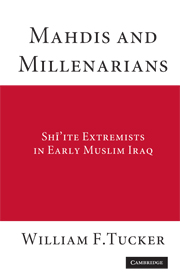Book contents
- Frontmatter
- Contents
- Acknowledgments
- Preface
- Mahdis and Millenarians
- Introduction: Historical Background – Umayyad Rule
- 1 Earlier Movements
- 2 Bayān ibn Sam‵ān and the Bayāniyya
- 3 Al-Mughīra ibn Sa‵īd and the Mughīriyya
- 4 Abū Mansūr al-‵Ijlī and the Mansūriyya
- 5 ‵Abd Allāh ibn Mu‵āwiya and the Janāhiyya
- 6 Influence and Significance of the Four Sects
- Conclusion
- Epilogue
- Bibliography
- Index
Conclusion
Published online by Cambridge University Press: 04 December 2009
- Frontmatter
- Contents
- Acknowledgments
- Preface
- Mahdis and Millenarians
- Introduction: Historical Background – Umayyad Rule
- 1 Earlier Movements
- 2 Bayān ibn Sam‵ān and the Bayāniyya
- 3 Al-Mughīra ibn Sa‵īd and the Mughīriyya
- 4 Abū Mansūr al-‵Ijlī and the Mansūriyya
- 5 ‵Abd Allāh ibn Mu‵āwiya and the Janāhiyya
- 6 Influence and Significance of the Four Sects
- Conclusion
- Epilogue
- Bibliography
- Index
Summary
It is by virtue of the fact that the groups examined in this study were millenarian movements that they are of more general significance. Many scholars have studied the phenomenon of millenarism, as pointed out often in the preceding chapters. Millenarian groups, they have shown, have existed at different times and in virtually every part of the world. Norman Cohn, years ago, laid the groundwork for millenarian studies with his important volume devoted to the chiliastic groups of medieval and Reformation Europe. Vittorio Lanternari, in his work The Religions of the Oppressed, has more recently elucidated the role of millenarism, in this case, among those nations and peoples subjected to European colonization in the nineteenth and twentieth centuries. The universal nature of millenarism can be seen from the range of essays appearing in the Archives de Sociologie des Religions (volume IV, 1957, and volume V, 1958), many of which are referred to throughout this book. Regardless of the time or region, millenarian movements appear to have certain features in common, as we have seen.
In any final assessment of these sects, one must address the issue of why those interested in millenarism should study the ideas and actions of these seemingly marginal groups. The most obvious response to this query is to point out the role of millenarian groups or tendencies present in the Muslim world today.
- Type
- Chapter
- Information
- Mahdis and MillenariansShiite Extremists in Early Muslim Iraq, pp. 133 - 137Publisher: Cambridge University PressPrint publication year: 2008

